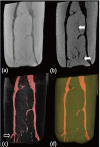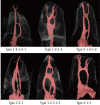In-depth morphological study of mesiobuccal root canal systems in maxillary first molars: review
- PMID: 23493453
- PMCID: PMC3591580
- DOI: 10.5395/rde.2013.38.1.2
In-depth morphological study of mesiobuccal root canal systems in maxillary first molars: review
Abstract
A common failure in endodontic treatment of the permanent maxillary first molars is likely to be caused by an inability to locate, clean, and obturate the second mesiobuccal (MB) canals. Because of the importance of knowledge on these additional canals, there have been numerous studies which investigated the maxillary first molar MB root canal morphology using in vivo and laboratory methods. In this article, the protocols, advantages and disadvantages of various methodologies for in-depth study of maxillary first molar MB root canal morphology were discussed. Furthermore, newly identified configuration types for the establishment of new classification system were suggested based on two image reformatting techniques of micro-computed tomography, which can be useful as a further 'Gold Standard' method for in-depth morphological study of complex root canal systems.
Keywords: Clearing technique; Mesiobuccal root; Micro-computed tomography; Minimum-intensity projection; Three-dimensional volume rendering.
Conflict of interest statement
No potential conflict of interest relevant to this article was reported.
Figures






Similar articles
-
Comparison of alternative image reformatting techniques in micro-computed tomography and tooth clearing for detailed canal morphology.J Endod. 2014 Mar;40(3):417-22. doi: 10.1016/j.joen.2013.09.014. Epub 2013 Oct 25. J Endod. 2014. PMID: 24565663
-
Assessment of the presence of a second mesiobuccal canal in maxillary first molars according to the location of the main mesiobuccal canal-a micro-computed tomographic study.Clin Oral Investig. 2021 Jun;25(6):3937-3944. doi: 10.1007/s00784-020-03723-5. Epub 2021 Jan 6. Clin Oral Investig. 2021. PMID: 33404762
-
A Cone-beam Computed Tomographic Study of Root and Canal Morphology of Maxillary First and Second Permanent Molars in a Thai Population.J Endod. 2018 Jan;44(1):56-61. doi: 10.1016/j.joen.2017.08.020. Epub 2017 Oct 20. J Endod. 2018. PMID: 29061352
-
Three root canals in the mesiobuccal root of maxillary molars: case reports and literature review.J Endod. 2014 Dec;40(12):2087-94. doi: 10.1016/j.joen.2014.07.034. Epub 2014 Oct 16. J Endod. 2014. PMID: 25443283 Review.
-
Computerized tomography technique for the investigation of the maxillary first molar mesiobuccal root.Int J Dent. 2013;2013:614898. doi: 10.1155/2013/614898. Epub 2013 Sep 8. Int J Dent. 2013. PMID: 24089614 Free PMC article. Review.
Cited by
-
Mesiobuccal Root Canal Morphology of Maxillary First Molars in a Brazilian Sub-Population - A Micro-CT Study.Eur Endod J. 2020 Jun 3;5(2):105-111. doi: 10.14744/eej.2020.29291. eCollection 2020. Eur Endod J. 2020. PMID: 32766519 Free PMC article.
-
Cone-beam computed tomography evaluation of maxillary first and second molars in Iranian population: a morphological study.Iran Endod J. 2014 Summer;9(3):190-4. Epub 2014 Jul 5. Iran Endod J. 2014. PMID: 25031592 Free PMC article.
-
Root Morphology and Canal Configuration of First and Second Maxillary Molars in a Selected Iranian Population: A Cone-Beam Computed Tomography Evaluation.Iran Endod J. 2017 Summer;12(3):288-292. doi: 10.22037/iej.v12i3.13708. Iran Endod J. 2017. PMID: 28808452 Free PMC article.
-
Comparison of the implementation of extra root canal treatment before and after fee schedule change in the Taiwan National Health Insurance System.J Dent Sci. 2018 Jun;13(2):145-150. doi: 10.1016/j.jds.2017.07.004. Epub 2017 Nov 11. J Dent Sci. 2018. PMID: 30895110 Free PMC article.
-
Cone beam computed tomography analysis of the root and canal morphology of the maxillary second molars in a Hail province of the Saudi population.Heliyon. 2023 Aug 26;9(9):e19477. doi: 10.1016/j.heliyon.2023.e19477. eCollection 2023 Sep. Heliyon. 2023. PMID: 37681163 Free PMC article.
References
-
- Kim Y, Chang SW, Lee JK, Chen IP, Kaufman B, Jiang J, Cha BY, Zhu Q, Safavi KE, Kum KY. A micro-computed tomography study of canal configuration of multiplecanalled mesiobuccal root of maxillary first molar. Clin Oral Investig. 2012 Oct; [Epub ahead of print]. doi: 10.1007/s00784-012-0852-8. - DOI - PubMed
-
- Versiani MA, Pécora JD, de Sousa-Neto MD. Root and root canal morphology of four-rooted maxillary second molars: a micro-computed tomography study. J Endod. 2012;38:977–982. - PubMed
-
- Du Y, Soo I, Zhang CF. A case report of six canals in a maxillary first molar. Chin J Dent Res. 2011;14:151–153. - PubMed
-
- Badole GP, Bahadure RN, Warhadpande MM, Kubde R. A rare root canal configuration of maxillary second molar: a case report. Case Rep Dent. 2012;2012:767582. doi: 10.1155/2012/767582. Epub 2012 Jul 8. - DOI - PMC - PubMed
LinkOut - more resources
Full Text Sources
Other Literature Sources
Miscellaneous

